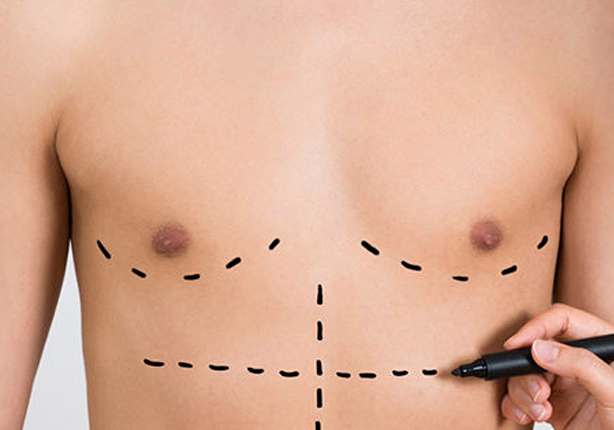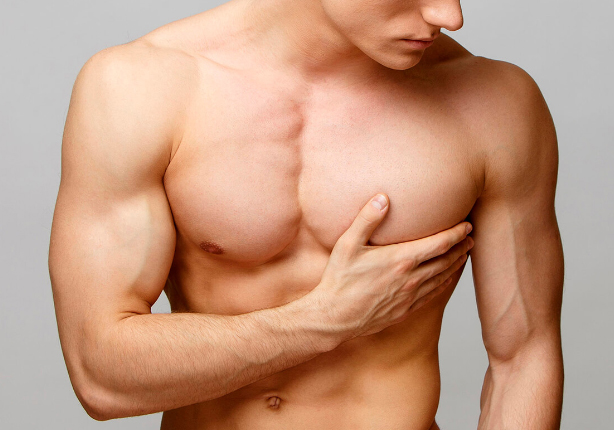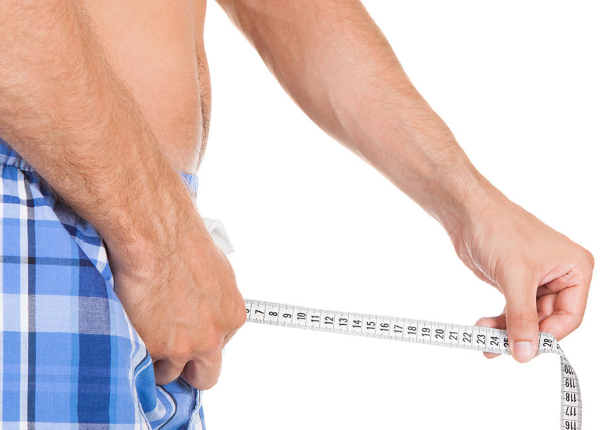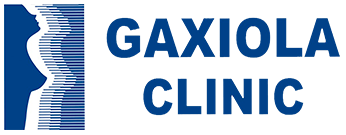Is a disorder on the development of mammary glands in men the disorder can occur in one or both breasts, this abnormal growth can be caused by an unbalance in the hormones. The growth of breast in men can be more common when they are overweight due to the effect of obesity in the body it is also common in people that take steroids.
The surgery consists in the removal of mammary glands and can be combined with liposuction, the incision is made around the areola, this way the scar is less visible, through this incision the excess of gland tissue is removed as well as fat and excess skin if it is necessary. This procedure is made under sedation and local anesthesia and it takes around one to two hours to be done. Recovery time is one week.

Pectoral Implants
The pectoral implants is a surgical procedure that normally the bodybuilders request and consists making an incision in the axillary area creating a bag of the wanted size to place the implant adjusting it to the treated area for the symmetry. Can be performed with sedation and local or general anesthesia.
The procedure lasts about an hour and a half and requires one week of rest avoiding hard work for three weeks.

Penis Enlargement – Phalloplasty
This is a procedure for man that want penis enlargement in lenght and thickness.
This is possible applying regionl anesthesia, performing an augmentation of the penis by liberating a ligament that keeps the penis retracted from the base of it thru the symphysis of the pubis. It’s done making a small incision in the area of the pubic hair.
Thru the same incision is injected fat tissue to increase the thickness of the penis. The grafting of fat and dermis are taken from under the butt and the fat graft from the lower area of the abdomen, like a liposuction.

Liposuction
Liposuction is a procedure that sculpts the body through the removal of unwanted fat deposits from specific areas (abdomen, hips, buttocks, thighs, knees, arms, double chin). There are several types of anesthesia that can be used to perform a liposuction, yet the most common practice is to use local anesthesia and a sedative only. The length of procedure varies from patient to patient and is dependent on the areas to be treated and the quantity of fat to be removed. There are times when the same body fat is used to fill other areas of the body, such as the buttocks.

It’s important that the patient follow the medical prescription of post-operative care.
How Visible Will Rhinoplasty Scars Be?
While it is true that as a result of all surgery there are scars, and the nose is not the exception, it will depend on the medical indication and the technique to follow that they remain hidden or visible.
Open Rhinoplasty and Closed Rhinoplasty.
Closed rhinoplasty: In this type of nasal approach the incisions are internal, therefore the scars are not visible.
Open Rhinoplasty: Although most of the incisions are internal, there is a mid-level incision of the columella, which serves to lift the mucocutaneous nasal flap and thus exposing the nasal structures.
How Long Will Recovering After Surgery Take?
In most cases, patients can return to their daily occupations within 8 to 10 days.
Postoperative Complications
The appearance of swelling and bruising in the intervened area is frequent, manifestations that subside after a week.
If the postoperative period is good, recovery will also be
In general, for the recovery to be as fast as possible it is important to follow to the letter the advice given by the doctor in each specific case. This implies that you have to have a little patience, because until the recovery is not total the patient will not be able to fully return to normal life and will be limited when doing certain things.
The normal thing is that in a period of four to six weeks the nose is fully recovered and can already perform all kinds of activities. Yes, it is recommended to apply daily quality sunscreen in the area until at least three months have passed since the operation.
10 Post-operative Care of Rhinoplasty
1.Follow a proper diet: It is very normal that nausea and even vomiting may appear during the 24 hours following the operation due to anesthesia. To reduce this type of discomfort to the maximum, it is advisable to make a liquid diet during the first day: soups, purées, infusions … From the second day the patient can recover little by little his normal diet depending on how they improve the stomach discomfort. After the intervention, analgesics for pain are usually prescribed; It is important not to take them on an empty stomach, since they can cause nausea and damage the stomach.
2. Make absolute rest: That rhinoplasty is not a large operation does not mean that you do not have to rest. During the first 24 hours the rest must be absolute, and in the following 15 days a moderate rest must be carried out, avoiding the activities that imply an intense physical effort.
3. Do not blow your nose: Patients who are going to undergo rhinoplasty have many doubts about whether or not they can blow their noses. The specialists advise not to do it after the operation until after two weeks to avoid that some hemorrhage can take place. As much as possible, you also have to avoid laughing, crying or gesturing with your face. Sneezing is something totally inevitable, but as long as the recovery lasts it must always be done with an open mouth. This reduces pressure and prevents bleeding.
4. Perform nasal washes: The use of sea water for cleaning the nose is the best alternative to reduce the discomfort caused by internal wounds and scabs. In addition, this treatment helps, at the same time, to keep the nostrils hydrated.
5. Do not be overwhelmed with nasal congestion: It is normal that after an operation of this type appears nasal congestion. Decongestant sprays can be used, but only those that have been indicated by the specialist and following their indications to the letter. If the patient notices any discomfort, such as dryness, itching or sneezing, you should consult your doctor quickly.
6.Beber water to avoid dry mouth: While the nose is plugged with the splints or plugs, the patient will have to breathe through the mouth, which can increase the dryness of this area. To reduce this annoying symptom it is best to drink water frequently.
7. Use a humidifier: The dryness in the nose and mouth is very normal after a rhinoplasty intervention. A simple way to alleviate this problem is to use a humidifier, especially at night. Decongestant substances such as menthol or eucalyptus can be added to the water of this device.
8.Follow medical prescriptions: Self-medication is always bad, but it is especially dangerous after an operation. The patient who has undergone rhinoplasty should not take more medications than those prescribed by his surgeon.
If the patient has some type of disease or pathology that makes it necessary to take other drugs, you should consult the subject with the surgeon before the operation.
9. Accepting emotional changes during the postoperative period: It is relatively common for those who undergo an operation to suffer a brief period of depression after surgery. It is normal due to the swollen appearance of the face, the discomfort of recovery and the limited that the patient sees, sometimes, to make his normal life during the first weeks.
The problem usually disappears as the recovery progresses, but if this emotional state does not improve after a few weeks it is advisable to go to a specialist.
10. Acquire the surgeon in case of emergency: The surgeon will inform the patient of the effects that are normal after the operation, as well as those that are not. If a problem appears in the eyesight, the patient suffers severe pain that does not remit with antibiotics, has a fever above 37.5 degrees or suffers watery and clear secretions, you must see the doctor immediately.

